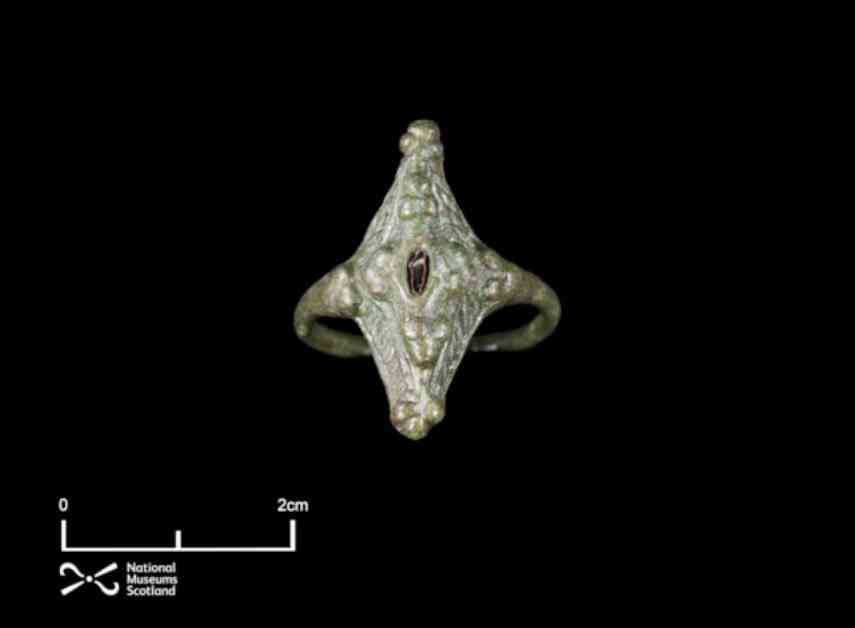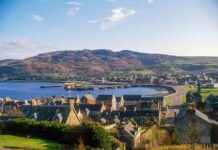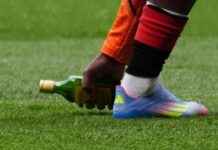An amateur archaeologist has made a remarkable discovery on the final day of a dig, unearthing a rare Pictish ring that had been buried for over 1,000 years. The kite-shaped ring features a garnet or red glass center and was found at Burghead fort in Moray by volunteer John Ralph, a former engineer and graduate of the University of Aberdeen.
Historical Value of the Site:
Burghead fort is known as a former Pictish site, but much of its historical significance was lost when the town of Burghead was constructed in the 1800s. The construction of the town covered a significant portion of the fort and resulted in the dismantling of remaining stones, which were used for building new homes. Despite this, the area still holds valuable historical artifacts waiting to be discovered.
Mr. Ralph’s Background:
The timing of the discovery coincides with Mr. Ralph’s 50th year of association with the University of Aberdeen. Growing up in the area, Mr. Ralph’s ancestors moved to Burghead to support the fishing industry. His personal connection to the town led him to volunteer for excavations at Burghead fort after seeing a post by Aberdeen University archaeology professor, Gordon Noble.
Excitement of the Discovery:
Describing himself as an “enthusiastic amateur,” Mr. Ralph initially did not realize the significance of the ring when he first discovered it. He recalled his experiences participating in various digs at Burghead and his tendency to get excited about shiny pebbles. It was only when a fellow volunteer recognized the importance of the find that Mr. Ralph realized he had stumbled upon something truly extraordinary.
Significance of the Find:
The discovery of the Pictish ring has sparked curiosity and excitement among archaeologists and historians. Mr. Ralph expressed his delight in contributing to the understanding of the past through this discovery, likening archaeology to a dot-to-dot picture where each find adds a piece to the larger puzzle. The ring offers a glimpse into the lives of the ancient inhabitants of Burghead and raises questions about its ownership and purpose.
Professor Noble’s Perspective:
Professor Gordon Noble, who has led excavation work at Burghead fort, described the find as “truly remarkable.” He highlighted the rarity of Pictish rings and the significance of finding one in such pristine condition. The discovery adds to the growing evidence that Burghead was a significant seat of power during the Pictish period, shedding light on the metalworking and high-status production in the region.
Future Analysis and Research:
The Pictish ring has been handed over to the National Museum of Scotland for further analysis. Professor Noble and his team will examine the ring, evidence of buildings, and other artifacts to better understand its origins and significance. The analysis will also delve into the craftsmanship of the ring and the potential social status of its owner, providing valuable insights into Pictish society and culture.
Importance of the Find:
Susan O’Connor, head of grants at Historic Environment Scotland, emphasized the significance of the discovery in understanding Pictish lives and society. While the materials used in the ring may not hold monetary value today, they offer valuable insights into the craftsmanship and social structures of the Pictish people. The ongoing investigations by the National Museum of Scotland are expected to reveal more about the ring and its historical context.
Conclusion:
In conclusion, the discovery of the rare Pictish ring at Burghead fort marks a significant milestone in the understanding of Pictish history and culture. The find has captured the imagination of archaeologists, historians, and the public, offering a unique glimpse into the lives of ancient inhabitants. As further research and analysis unfold, the ring is poised to reveal more about the intricate craftsmanship, social structures, and power dynamics of the Pictish period. This discovery serves as a testament to the enduring allure of archaeology and the endless mysteries waiting to be unearthed from the past.
































